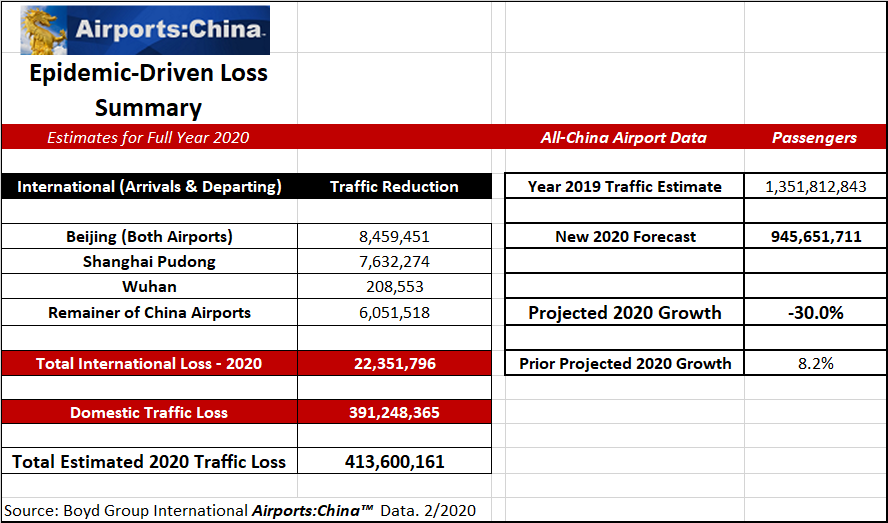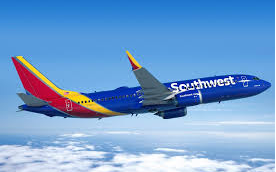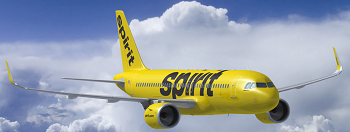Forecast Observations Regarding China’s Global Coronavirus
Semi-Positive – For Now. Year 2020 US Traffic May Still Exceed 2019
As of today our Airports:USA® forecasts are being re-structured to anticipate the downward effects of China’s CONVID-19 epidemic on air travel demand.
While there’s no doubt that bookings have taken a near-term decline, it’s difficult to forecast how long this will continue, based on the range of differing information coming from a myriad of sources regarding the depth and danger of the epidemic.
That’s the core challenge facing U.S. airlines – the public is not well informed on the epidemic, because the effects of coronavirus as they will manifest in the USA aren’t clear.
We see the social videos coming out of China – where people literally drop in the streets. We hear about 500+ deaths in Italy. The death toll in Iran.
Then we hear about older people in nursing homes in Washington state.
What’s tough to forecast are a) what segments of the consumer base are most likely to shy away from travel, b) what is the core rationale for doing so, and can that be addressed by better understanding of the epidemic as it is manifesting in the US, and c) how long will the expansion of the virus go on. This last point is the most critical.
The USA Isn’t Like China. Or Europe
One issue is that our medical system in the US is centuries ahead of that in China. Out in the provinces, beyond the flash and glare of shiny new cities, hygiene and medical support are deplorable.
And to be clear, the responsibility for this crisis lies entirely with the government of China.
For whatever political motivations, it is clear that even after the virus was known to be easily communicated between individuals, the Chinese government intentionally encouraged people to mingle in Wuhan, to “prove” there was no epidemic – all for political reasons. Then came the Lunar New Year migration of people to all parts of China and the world. (This is covered in several posts at www.BoydGroupChina.com, by the way.)
Looking Ahead – 2020 Traffic At Or Slightly Above 2019
Based on announced and expected capacity reductions, we are forecasting a near-term decline in US traffic demand of 10% overall between March and end of May. By that time, it is logical to assume that there will be a clearer understanding of how the spread of the disease can be minimized.
Putting this projection- which at this point is very raw – in context, it would point to 2020 still being slightly ahead of 2019. The strong economy was in line to gobble up the expected increases in capacity for 2020.
In the meantime…
Cruise Ship Traffic – Free Fall. For the foreseeable future, the Love Boat is in financial drydock, perhaps as an industry.
Any US airport that has cruise ship traffic – such as FLL, MIA and MSY, would do well to assume that portion of passengers has vaporized.
With the repeated stories of infections on these cruises, that entire industry is in for a very tough future. Some media sources, reflecting on the large number of infections on several ships, has referred to them as “floating petri dishes.”
Asian Traffic. We generated airport-specific projections of traffic loss at key US-Asia gateway airports. There will be a drop in trans-Pacific demand until this epidemic is gone and mostly forgotten.
This is particularly true of China, where the government single-handedly has now destroyed its global reputation and value as a leisure destination, possibly as well as an investment venue, due to its continuing dishonest handling of the epidemic, starting with efforts to “prove” it did not exist, covering up reports, doctoring data, and lying about the spread of the virus.
European Traffic. Uncertain. The outbreaks in Lombardy and Northern Italy will likely keep traffic down until there is demonstrative elimination of outbreaks.
Small Community Air Access. If the three major network carriers continue to cut capacity, feed connections at some of their hubs may be at a premium. In that case, low-performing feed markets from small airports may see cuts.
More Data This Week
We should have a clearer picture of airline responses later this week… we will keep our clients advised.
____________
And Speaking of BoydGroupChina.com –
Bookmark It For Straight Talk Regarding CONVID-19 Effects On Aviation
For ongoing data and information on CONVID-19 developments that affect aviation in China as well as the rest of the globe, we’re routinely updating the Insights page at www.BoydGroupChina.com. It is the new source of hard information on China’s air transportation system.
Historical Data. We have monthly national statistics regarding traffic by sector and region. In the future, we will be generating additional airport-specific information.
Forecast Accuracy. We’re proud to note that our Airports:China™ forecast for 2019 airport traffic was within less than half a percentage point of the number just reported by CAAC.
Independent Perspectives That Challenge “Official” Information. In the Insights section, however, we do not get anywhere near that close to political correctness.
Using a range of sources and information – not just “official” statements – some of the troubling factors in this CONVID-19 situation are covered.
What Happens In China Affects Air Transportation In China & Elsewhere. Just about any major event in China will drive changes in air travel patterns and demand.
So, BoydGroupChina is not reticent to address and analyze these issues.
These include reviews of the initial government reticence to be up front about the virus, the threats to medical professionals to not “spread rumors” by talking about the virus, incarcerating people covering the event on social media, and embarrassing missives from the government, such as claiming that air travel is completely safe… as long as you don’t sit near an infected person. (Cannot make this up.)
We also discuss the possible lack of candor and reliability of information coming from the Chinese government regarding the actual spread of the virus. There is evidence that it is possibly still out of control, and the numbers are “managed.” Indeed, much of China is economically still shut down.
We relate these major events to shift in air capacity and service levels across the nation. The result in an insight source not found anywhere else.
Log On – We are developing this site to be the first independent source of data and information on aviation in China, and how it affects the U.S. and the rest of the globe.
______________
___________
THE STAFF AT BOYD GROUP INTERNATIONAL WISH YOU A PROSPEROUS WEEK AHEAD!










